Buraco is a melding card game which appears to be closely related to Canasta. Buraco originated in Uruguay in the 1940's and quickly spread to many other locales where it is quite popular, particularly Brazil.
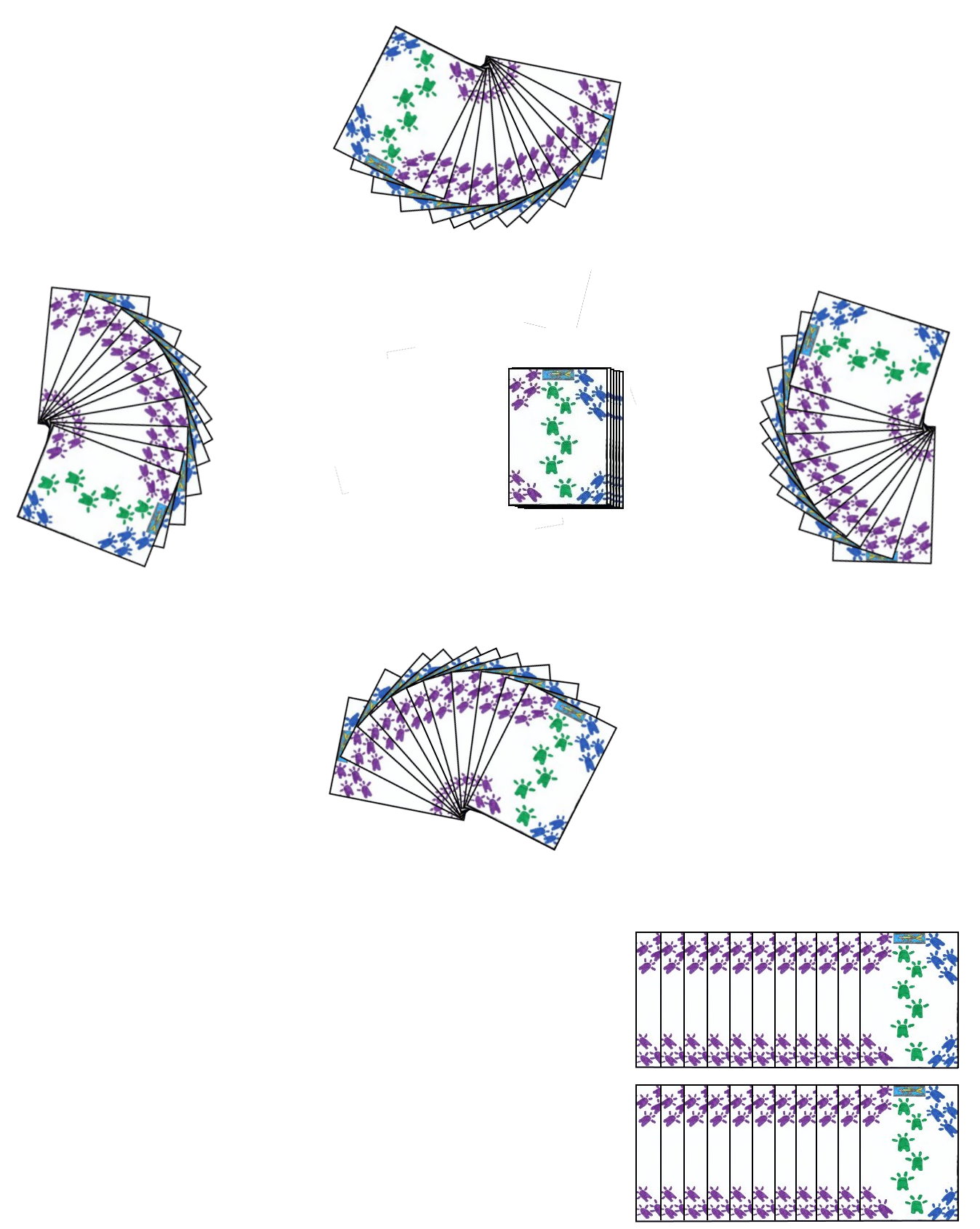
There are actually several versions of this game, with the most popular being Open, Open Dirty, Closed, No Trio Clean Run (NTCR) Closed, and Dirty and Closed. The rules described first are for the "Open Dirty" version, so called due to the rules regarding the discard pile and the types of melds allowed during the hand. However, rules for the various other types are given in the Variants section below.
The game is designed to be played by four players in two partnerships using two standard 52 card decks shuffled together
with the addition of four total Jokers. The ranking of the cards in this deck is as follows (from high to low); Ace, King, Queen, Jack, 10, 9, 8, 7, 6, 5, 4, 3, 2, Ace. Notice that the Ace is considered both the highest and lowest card in the deck, thus a sequence containing an Ace could either have this Ace as the highest card in the sequence or the lowest card in the sequence, but an Ace may never be used in the middle of a sequence and a sequence may never contain two Aces. Although the two has a natural ranking in the game, all twos are also considered wild cards and can be used to substitute for any other card in a meld. Jokers are, of course, also considered wild cards at all times and can be used to represent any other card in a meld.
Determination of partnerships can be performed in a number of ways with draw for low cards a common method. The two players drawing the two lowest cards would play as partners against the two players drawing the two highest. Each player should sit at the table directly across from his partner. The player who draws the lowest card of all is set as the first dealer, and for each subsequent hand, the role of dealer rotates around the table in a clockwise direction.
Once the first dealer has been determined, the dealer should then thoroughly shuffle the deck. After shuffling, he passes the face-down deck to the opponent to his immediate right. This player cuts the deck, attempting to pull exactly 22 cards from the top of the deck. If he is able to do so, his partnership immediately scores 100 points to their accumulated score. With these cards cut from the deck, the cutter deals two piles of 11 cards each. If he did not draw exactly 22 cards from the main deck he cuts additional cards as needed or replaces cards to the deck to create these two hands. These two hands (called the Pots) are set to one side of the table for use later in the game.
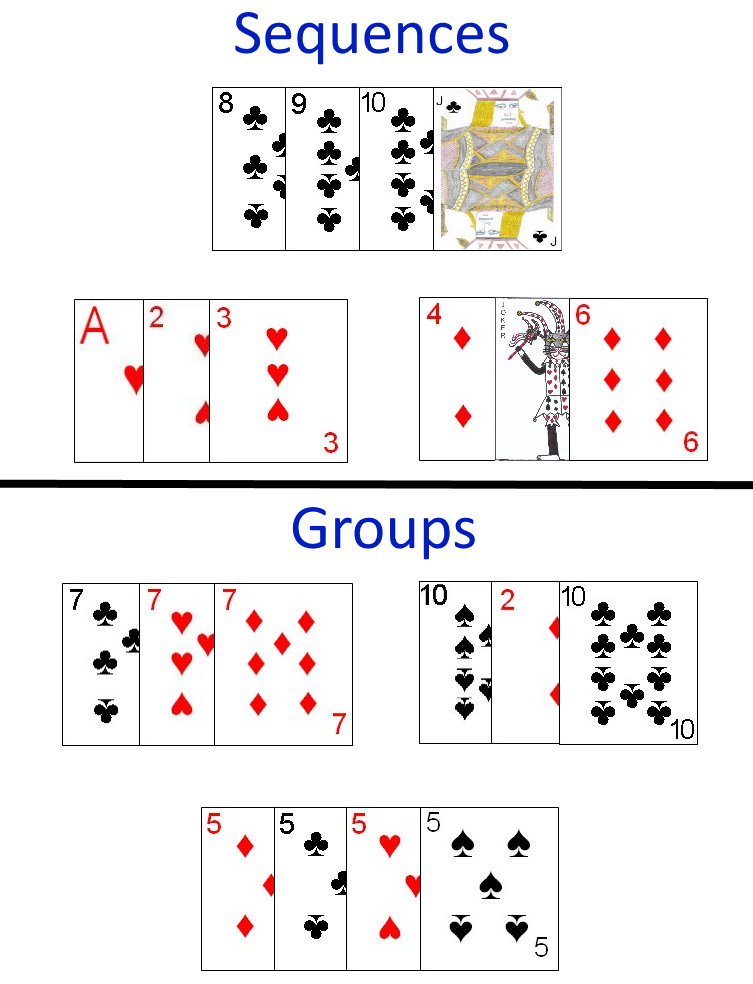
Meanwhile, the dealer begins dealing the cards around the table in a clockwise direction around the table, starting with the player to his immediate left. He continues dealing in this manner around the table, one card at a time until each player has 11 total cards (called that player's Hand). He then places the remainder of the cards in a face-down pile in the center of the table as the draw pile or stock.
As in most other games of the Rummy family, players will create melds from cards in the hand. The types of legal melds in Buraco are as follows:
- Sequence:
A sequence (also called a Run) is a meld consisting of three
or more cards, all of the same suit in direct sequential order. As mentioned previously the Ace is considered both the highest and lowest card in each suit, so, if a Sequence includes an Ace, that card must be at the extreme end of the meld.
- Group:
A group is three or more cards all of the exact same denomination, irregardless of the suits in the Group. A group consisting of three Jokers or three twos is not
permissible.
As previously mentioned, Jokers and all cards of rank two in the deck are considered
wild cards and can be used to replace any other card in a meld. However,
if a two can be used to represent itself in a meld, the two is not
considered a wild card and can be scored accordingly. These wildcards
can only be used in Sequences, and any sequence can only have, at most,
one such Joker or card of rank two (representing a wildcard).
In addition to these standard runs, certain longer Sequences also earn additional points when melded. Any sequence meld consisting of seven or more cards will earn these bonus points. There are two types of these special Sequence
melds each worth additional bonus points when melded:
- Clean Run:
A clean run is such a sequence of seven or more cards which contains no wild cards. It may contain a two as long as that two is actually in the place of the actual natural two of the appropriate suit. To designate a
clean run, traditionally the top two cards in the meld turned at a 90 degree angle to the rest
of the cards in that meld.
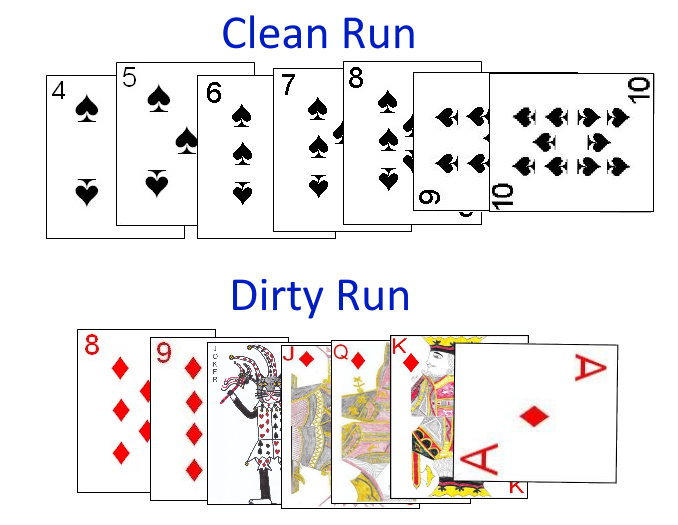
- Dirty Run:
A dirty run is a sequence of seven or more cards which
contains a wild card. No meld may contain more than one actual wild card. A
clean meld will become a dirty meld if any wild card is added to that meld.
It should be remembered that if a two is used as an actual two of the
appropriate suit, this card is not considered a wild card. A dirty run is traditionally indicated by
placing the top card displayed in the meld at a 90 degree angle to the rest
of the cards forming that meld.
The player to the immediate left of the dealer has the first turn, and thereafter the turns rotate around the table in a clockwise rotation. On the very first turn of the hand, since there is no discard pile, the play is slightly different than other turns. This first player draws the top card of the discard pile and looks at the card but does not yet add the card to his hand. If the card suits him, he may add the card to his hand. However, if he does not want to keep the card, he places it face-up next to the discard pile to start the stock pile and draws a new card from the stock and adds it to his hand. After the player takes a card, that player may then make any legal melds as appropriate, the player then discards any one card from his hand face-up on the stock pile.
After the first turn of the hand, each turn thereafter takes the form of first drawing a card (either the top card from the face-down stock pile or the entire discard pile) into his hand. Before making his draw, the player may view and re-arrange the discard pile as he likes, but if he wants to take any card from this
discard pile he must take the entire pile into his hand. After drawing the player then may make any melds as allowable and able and then, to conclude his turn, discards one card to the top of the discard pile. Each card to the discard pile should be discarded in a way such that it mostly overlaps the previous card in the discard pile, but allows that card to still be somewhat visible.
As noted above, there are two types of melds in Buraco, Sequences and Groups. Once a meld is made, a player may add to melds which have been melded by his partner
or himself but may not extend melds made by the opposing partnership. However, there are certain point requirements for the first meld of a hand. A partnership may not make an initial meld on the hand unless the total card point value of the meld is a certain amount. This required amount is based on that partnerships current score at the start of the hand. The following chart shows these meld point requirements:
| Team's Current Score | First Meld Point Requirement |
|---|
| Less then 1500 | 50 |
| 1500 or more | 75 |
This initial meld may be in one large meld or multiple smaller, legal melds, all made at the same time, on the same turn. Once a team has made the initial meld as per the requirement on the hand, they may then make any legal meld of any total, as well as add to existing melds made by their partnership. If a meld contains a two used as a wildcard or a Joker, that wildcard can be moved within the same meld by either member of the partnership who melded that card. However, the resulting meld after movement of the wildcard, must still be a legal meld. This would usually be done by a player who has the actual card for which the wild card is currently replacing, so they can then play that card and move the wildcard to the top or bottom end of that same meld. In order to determine the total value of a meld, each card making up that meld has a specific point total as shown on the following chart:
| Card | Point Value |
|---|
| Joker | 30 |
| Two (used as Wildcard or a natural card) | 20 |
| Ace | 15 |
| 8, 9, 10, Jack, Queen, King | 10 |
| 3, 4, 5, 6, 7 | 5 |
|
|
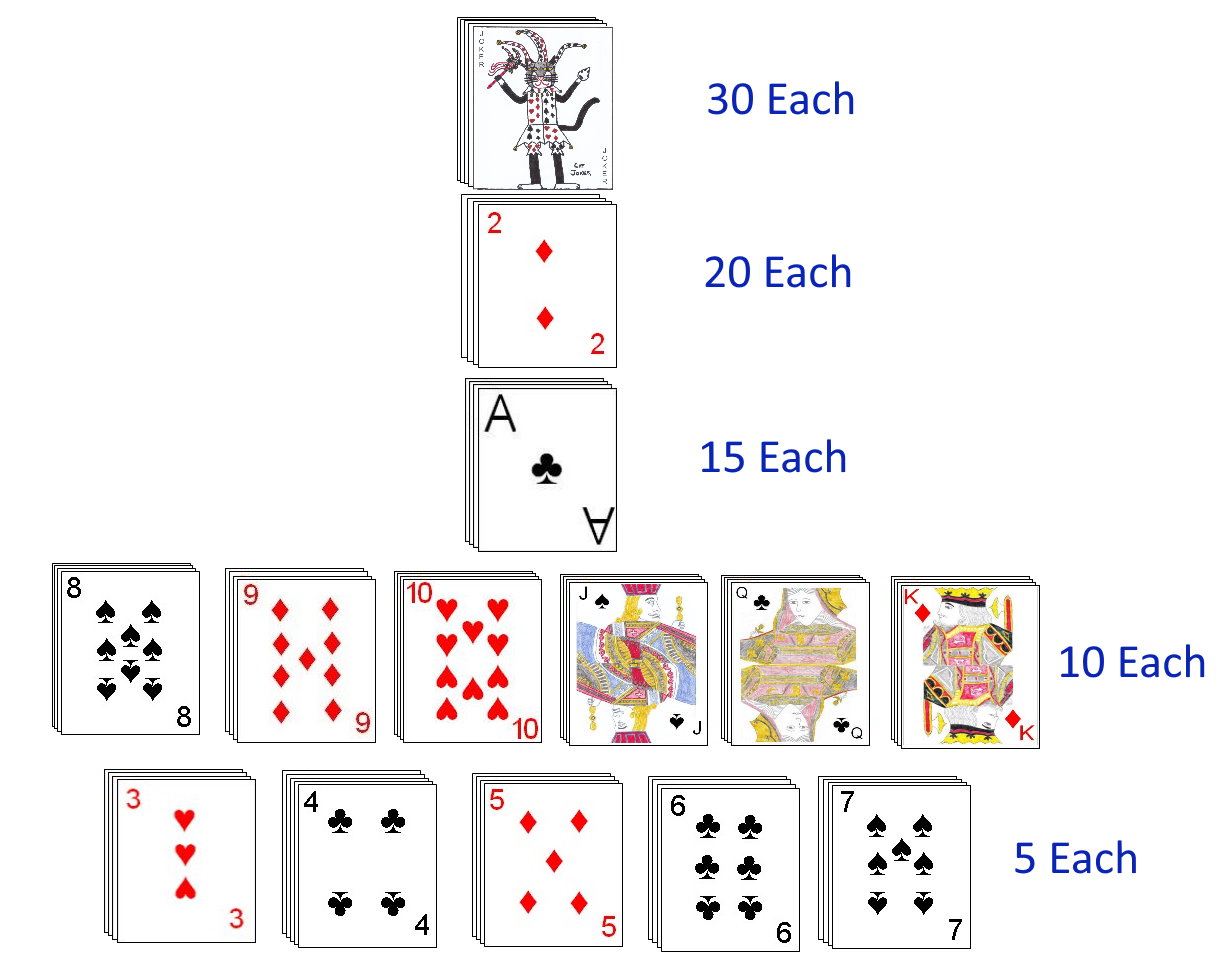 |
If a player, during his turn melds the last of the cards in his hand and
his team has not yet taken a hand from the "Pots", that player must take one of the "Pots" hands as his new hand. If he has not yet discarded on that
same turn, he may continue to play any legal melds from the new hand, and discards from the new hand at the end of his current turn. If a player empties his hand by his normal discard and neither member of his team has yet taken a card from the "Pots", that player takes the hand from the "Pots" into his hand but the turn moves to the next player in normal rotation and the player who drew the new hand should not look at his new hand until his next turn.
If, however a player discards his last card from his hand (the last card from that player's hand can not be used in a meld, the hand can only end in this way on a discard by a player) and either he or his partner has already taken a hand from the "Pots", this immediately ends the hand. However, there is a required stipulation that must be met before a player can play the last of the cards from his hand which would end the current hand. This stipulation is that one member of that player's partnership must have melded at least one Clean or Dirty
Run. If they have not yet done so, a player may never play the last card from a hand which would end the current hand.
If the stock pile runs out of cards while the game is still in
progress, the top hand from the "Pots" is then removed and placed to
start a new stock pile. If instead, the stock pile runs out and there are no hands left in the "Pots" the game immediately ends and the players would total up points based on the melds made and cards remaining in the hand. The following are the various points that can be earned or lost at the conclusion of the hand by each team:
- Each meld made by a team to the table earns that team the number of points represented by the meld based on the point values of it's composition of cards.
- Each Clean Sequence made by a partnership during the hand earns that team 200 bonus points.
- Each Dirty Sequence made by a partnership during the hand earns that team a 100 point bonus.
- Each card remaining in a player's hand, regardless if it could be added to an existing meld or make a new meld has the point value of that card subtracted from that player's team score.
- If a team manages to make a Royal Run (from Ace to King) using no wild cards, that team earns 500 bonus points.
- If a team did not pick up an extra hand from the "Pots" during the course of the hand, that team must subtract 100 points from it's current score.
- For a partnership who runs out of cards during the hand (called Closing), that team scores 100 bonus points.
Each team then calculates all points gained or lost during the hand. If one or both teams manage to earn a total score of 3000 or more accumulated points over the course of the game, that team is declared the winner. If both teams have reached or exceeded 3000 points, the team with the higher total score is declared the winner.
Optional Rules and Variations
As mentioned in the section above, in addition to the "Open Dirty" variant of Buraco of which the rules are detailed above, there are also several other versions of which are also commonly played. The following are some of the most common of these:
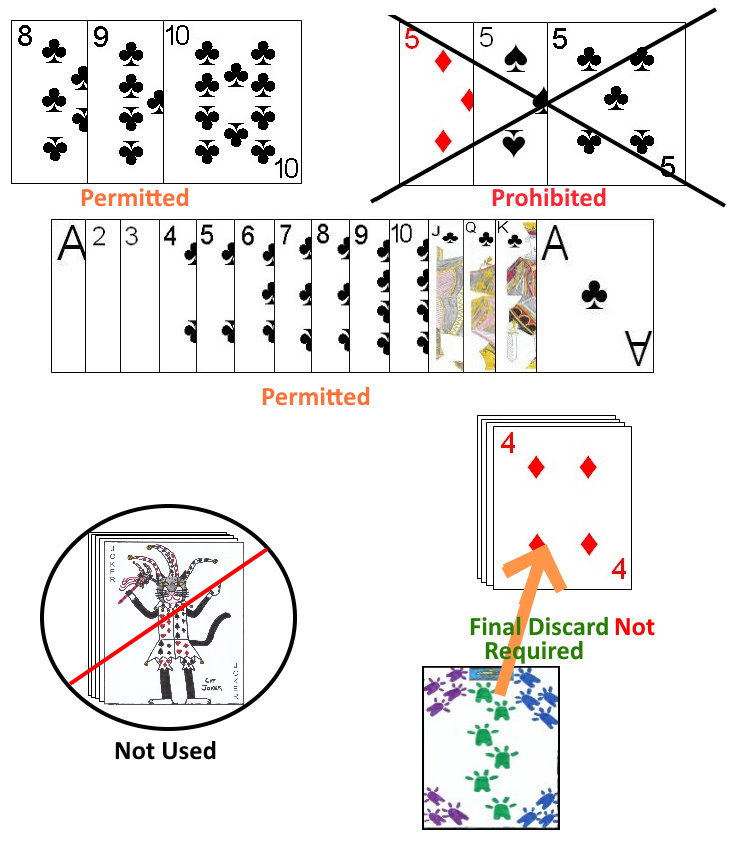 Open:
Open: The Open version is played very similarly to the "Open Dirty" version as described above. The following are the changes which differentiate this version from that as described above:
- The Jokers are removed and not used in play of the Open game.
- Melding of Groups are not allowed, and thus the only type of allowable melds are Sequences.
- A sequence meld from Ace to Ace is allowed, and if made, earns the team that made the meld 1000 bonus points for the feat.
- The scoring of the individual cards used in melds or remaining in a players hand is slightly different than in the version described above, as follows:
| Card | Point Value |
|---|
| Ace | 15 |
| Two (used as wildcard or a natural card) | 10 |
| 8, 9, 10, Jack, Queen, King | 10 |
| 3, 4, 5, 6, 7 | 5 |
- It is not necessary to end the hand with a discard, but a player can
also end the hand by playing his last card as part of a new or existing meld
to the table.
- The penalty for a team, which during a hand did not take a hand from the "Pots" also applies to that team for a player who has just taken the "Pots" but has not yet had a turn with this newly drawn hand.
In all other aspects "Open" Buraco is played identically to the "Open Dirty" version of Buraco.
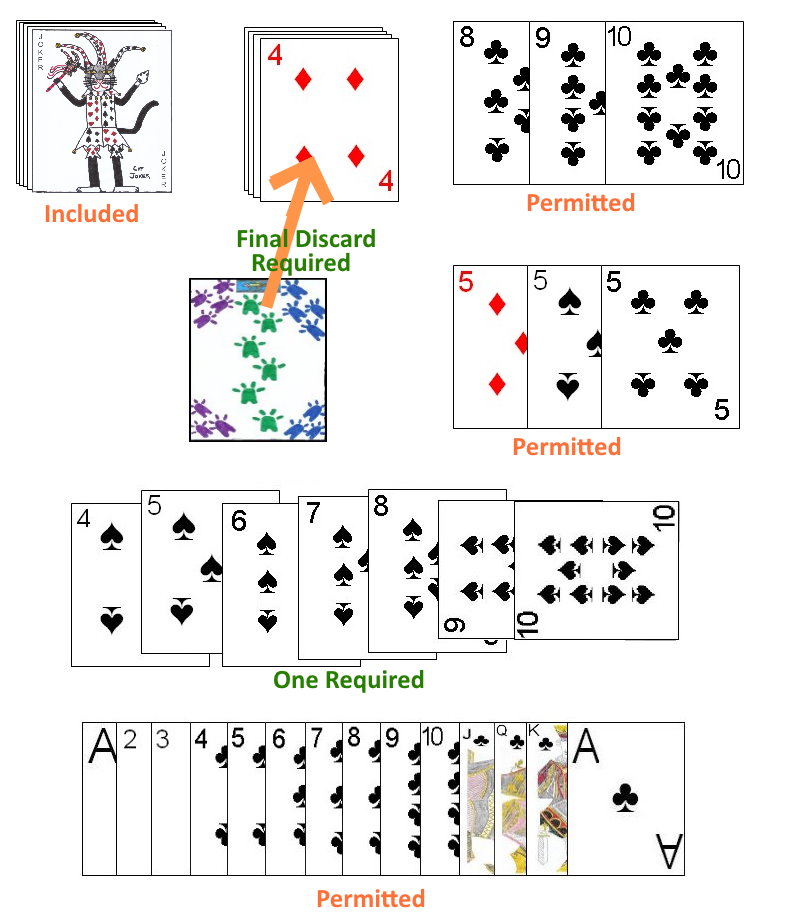 Closed:
Closed: Closed Buraco is also played quite similarly to the "Open Dirty" variant of the game. In fact the game is played identically save for the following differences:
- A team must have melded at least one Clean Run in order to go out and end the hand.
- A sequence meld running from Ace to Ace (with no wild cards) is allowed and earns the team that makes that meld a bonus of 1000 points.
- The scoring in this variant is slightly different, with the following chart showing the score for each card in the deck:
| Card | Point Value |
|---|
| Joker | 20 |
| Ace | 15 |
| Two (used as Wildcard or a natural card) | 10 |
| 8, 9, 10, Jack, Queen, King | 10 |
| 3, 4, 5, 6, 7 | 5 |
- The rules regarding the discard pile are also significantly changed. In this variant, the discard pile cannot be examined at any time and, in order to take the discard pile, the player taking the discard pile must use that top card in a legal meld immediately after taking the pile. In addition, the discard pile is squared up such that only the top card of the discard pile is visible from the discard pile.
- The penalty for a team, which, during the hand did yet not take a hand from the "Pots", also applies to that team if a player who has just taken the "Pots" but not yet had a turn with the newly drawn hand.
In all other aspects of the game, this variant is played identically to the "Open Dirty" variant of Buraco as described in the section above.
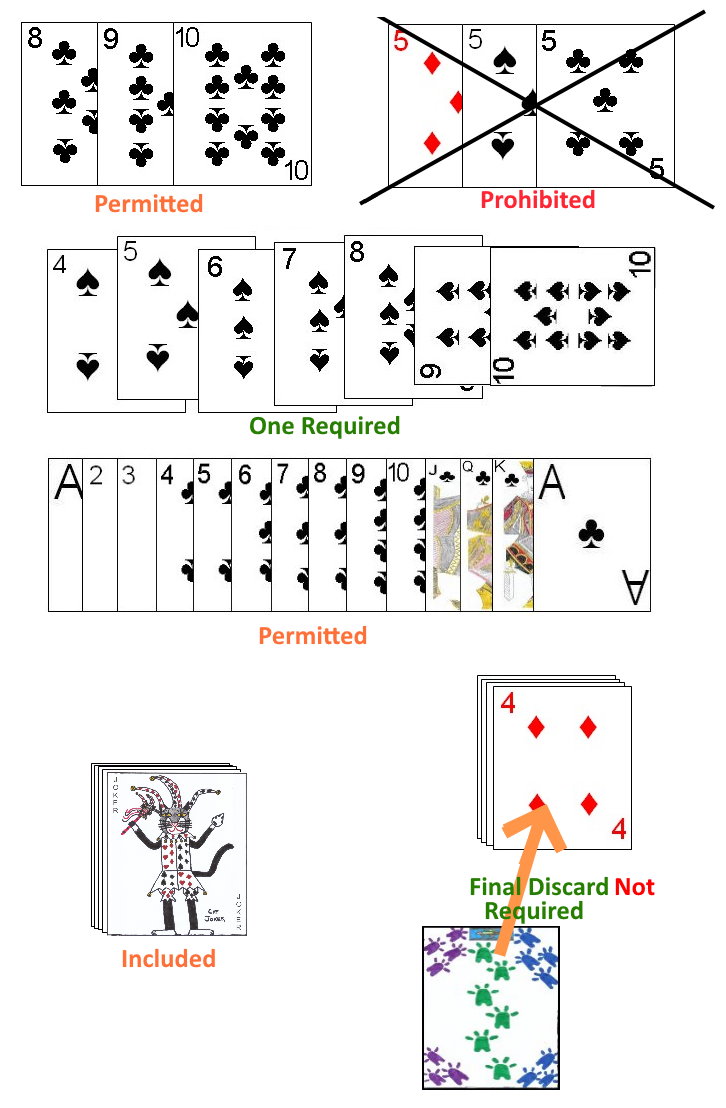 No Trio Clean Run (NTCR) Closed:
No Trio Clean Run (NTCR) Closed: This variant is also similar to the "Open Dirty" version as previously described. The following list shows the rule differences in this variant:
- Group melds may never be made. Thus, only Sequence melds are allowable, legal, melds.
- In order for a team to go out and end the hand, that team must have melded at least one Clean Run.
- A Sequence meld from low Ace to high Ace is allowed and doing so scores that team a 1000 point bonus.
- The scoring point value for each card is as follows:
| Card | Point Value |
|---|
| Joker | 20 |
| Ace | 15 |
| Two (used as Wildcard or a natural card) | 10 |
| 8, 9, 10, Jack, Queen, King | 10 |
| 3, 4, 5, 6, 7 | 5 |
- The rules in this variant regarding the discard pile, are similar to the Closed version. Thus, the discard pile may not be examined, and, in order to take the discard pile, the player taking the discard pile must use it's top card in a legal meld immediately after taking the pile. In addition, the discard pile should be retained in a format such that only the current top card from the discard pile is visible at any one time.
- It is not necessary to discard to end the hand. Rather, a player can also end the hand by playing his last card as part of a new or existing meld on the table.
- The point penalty for a team, who, during a hand did not take a hand from the "Pots" also applies to a team for a player who just took the "Pots" hand but has not yet had a turn with the newly drawn hand.
Other than these few differences, this version is played identically to the "Open Dirty" version as described at the top of this page.
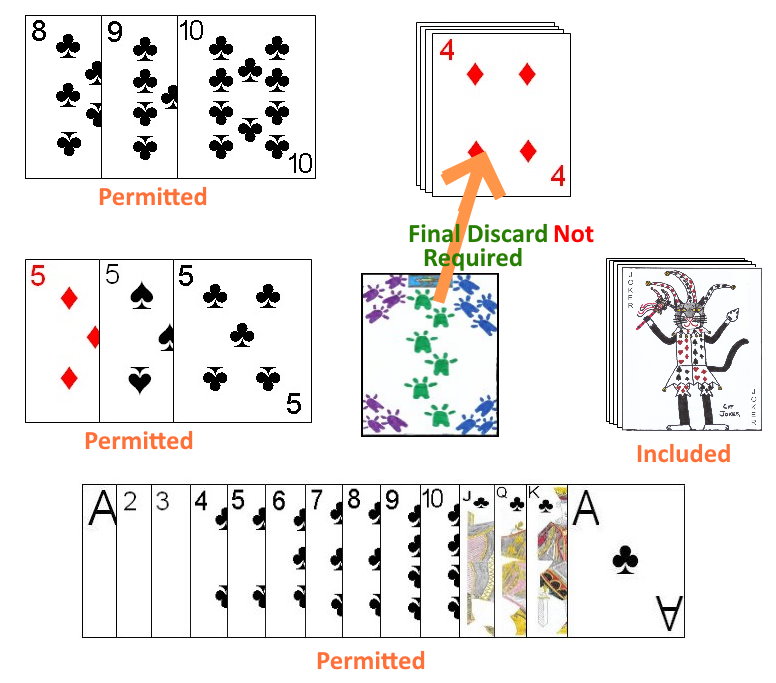 Dirty and Closed:
Dirty and Closed: This version is also played similarly to Open Dirty, with just the following exceptions in gameplay:
- A Sequence meld consisting of the cards from Ace through to Ace is allowed and such a meld scores the team making the meld a 1000 point bonus.
- The scoring in this variant is slightly different than from some other versions, as follows:
| Card | Point Value |
|---|
| Joker | 20 |
| Ace | 15 |
| Two (used as Wildcard or a natural card) | 10 |
| 8, 9, 10, Jack, Queen, King | 10 |
| 3, 4, 5, 6, 7 | 5 |
- It is not strictly necessary to end the hand on a discard. A player may also end the hand by playing his last card to an existing meld or as part of a new, legal meld.
- The rules regarding drawing from the discard in this variant are similar to those in the Closed version. The cards in the discard pile may not be examined or re-arranged and in order to take the discard pile (including it's top card), the player taking the pile must use it's top card in a legal meld immediately after taking pile. Also as in the Closed variant, the discard pile is kept in such a fashion such that only the top card of the discard pile is visible
from that pile at any one time.
- The penalty for a team, who during any hand has not yet taken a "Pots" hand, also applies to a team if a player has just taken the "Pots" hand due to a discard but has not yet had a turn with this newly drawn hand.
In all other ways, the Dirty and Closed variant is played identically to the "Open Dirty" variant as described previously.
Two Player Buraco: Buraco can, and often is, played by two players. Any of the versions above can be played using the same rules. The only difference between the four player variant being that there are no partnerships and each player plays independently.
Italian Burraco: A game almost identical to Buraco is also very popular in Italy. It is also spelled very similarly to the parent game, Buraco.
Italian Burraco is played identically to the Open Dirty version of Buraco as described above with the following differences:
- While the player who cuts the cards may still attempt to cut exactly 22 cards from the deck for dealing to the two extra hands, no bonus points are scored if he does manage this.
- After the dealer has finished distributing the cards to each player, he places the remainder of the pack face-up in the center of the table and takes the top card from this pile, placing it face-up beside the stock pile
to start the discard pile.
- Since, in Italian Burraco, there is a discard pile at the start of the
game, the first player takes his turn as does every other player, and may start that turn by either drawing from the stock pile or taking the discard pile (which at this time will consist of just the one face-up card).
- A team may never have more than one group (also called a set) of cards of the same rank, and would simply add any later cards of that same rank to the previous meld of that rank.
- A meld consisting of all twos or Jokers is not permitted.
- While an Ace can be either considered high or low in a sequence meld (high after the King, or low before the two, a sequence can never contain more than one Ace.
- A specific team may have two valid sequence melds of the same suit on the table at the same time, but the cards from these sequences may never be moved amongst the sequences nor may the sequences be combined.
- If a sequence meld contains a Joker or a two representing a wild card (rather than a natural card of rank two in the actual position of a two of that suit), the actual card which the Joker or two represents may be substituted for that wild card and the wild card moved to one end of the meld to represent a missing card from the meld. If the meld is already a full meld, from Ace to King, the wild card is simply added to the end of the meld, and is considered to be an extra card in that particular meld.
- A team may go out to end the hand if one member of that team has taken
one of the extra hands (called the pozzettos in this variant), melded at
least one Burraco (a group meld or sequence meld containing at least seven cards and containing no wild cards) and lastly ends the hand with a discard. A wild card may never be discarded to end the hand.
- If, at the start of a turn there are only two cards remaining in the draw pile, that hand immediately ends and is scored.
- The discard pile is stacked in such a manner that only the current top card of that pile is visible at any time.
- If the discard pile contains just one card and for four turns in a row no one draws from the stock pile (each drawing the last discard), the hand immediately ends and is scored. This is called a stalemate.
- There is no card scoring requirement for the first meld made by a team on any turn. A player, on his turn may make any legal melds as he prefers.
- The first team to reach or exceed 2000 total accumulated points is
declared the winning partnership of that game.
In all other aspects Italian Burraco is played identically to the Open Dirty version of Buraco as described at the top of this page.
Copyright © 2015 CatsAtCards.com. All rights reserved.
 There are actually several versions of this game, with the most popular being Open, Open Dirty, Closed, No Trio Clean Run (NTCR) Closed, and Dirty and Closed. The rules described first are for the "Open Dirty" version, so called due to the rules regarding the discard pile and the types of melds allowed during the hand. However, rules for the various other types are given in the Variants section below.
There are actually several versions of this game, with the most popular being Open, Open Dirty, Closed, No Trio Clean Run (NTCR) Closed, and Dirty and Closed. The rules described first are for the "Open Dirty" version, so called due to the rules regarding the discard pile and the types of melds allowed during the hand. However, rules for the various other types are given in the Variants section below.
 Meanwhile, the dealer begins dealing the cards around the table in a clockwise direction around the table, starting with the player to his immediate left. He continues dealing in this manner around the table, one card at a time until each player has 11 total cards (called that player's Hand). He then places the remainder of the cards in a face-down pile in the center of the table as the draw pile or stock.
Meanwhile, the dealer begins dealing the cards around the table in a clockwise direction around the table, starting with the player to his immediate left. He continues dealing in this manner around the table, one card at a time until each player has 11 total cards (called that player's Hand). He then places the remainder of the cards in a face-down pile in the center of the table as the draw pile or stock.





